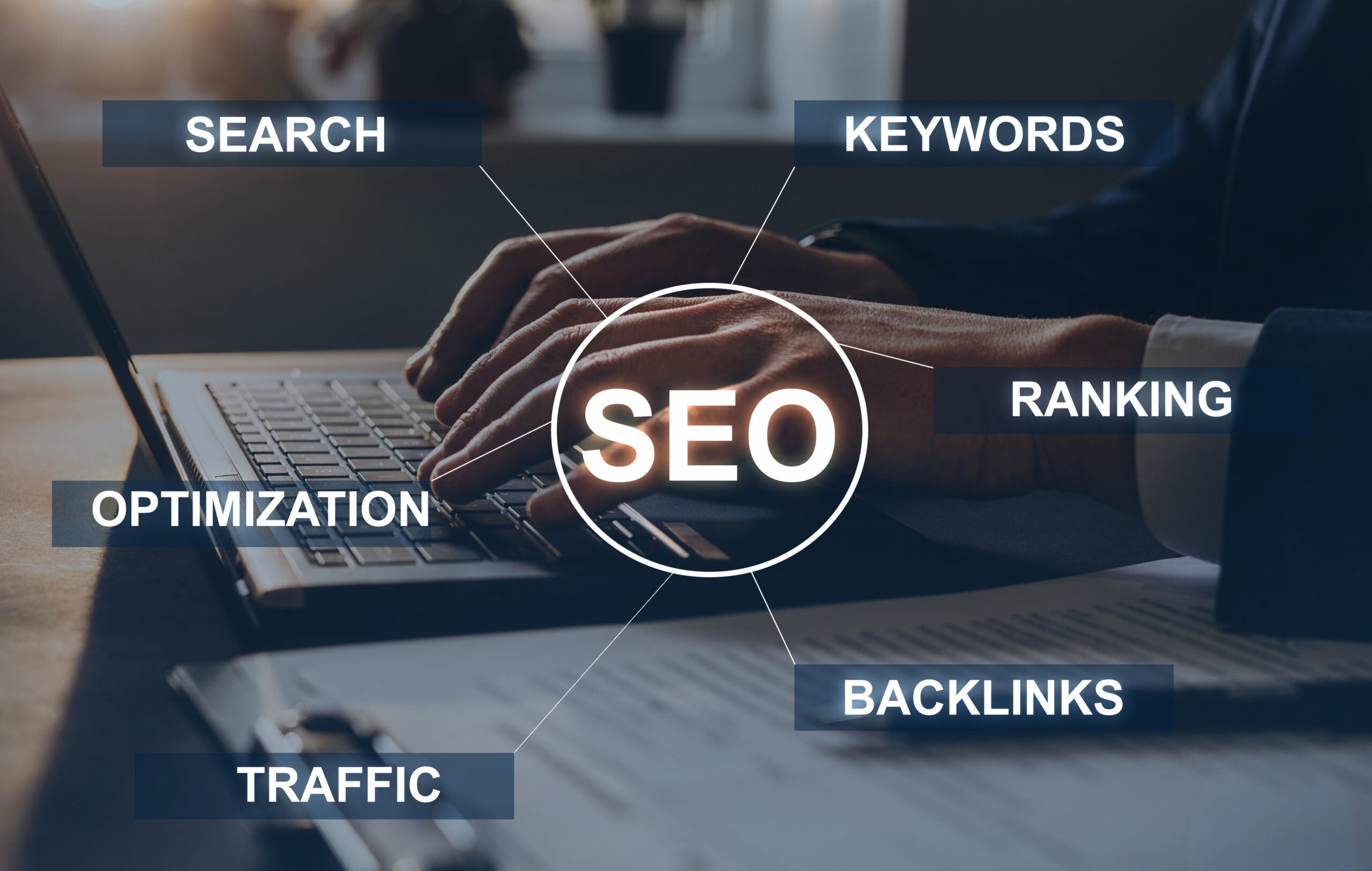
Congratulations, you’ve got your new business up and running and you’re ready to optimize your website. But you’re not sure how to start SEO. In this article, we cover the most accessible fundamentals and best practices: building an SEO-friendly website, on-page SEO, and off-page SEO/outreach.
SEO is a long game. For small business owners who happen to be busy, the useful SEO mantra is ‘little and often.’
What is SEO?
Search Engine Optimization or ‘SEO’ is a digital marketing process that aims to drive organic traffic to your website. SEO involves optimizing your website to make it more visible to search engines like Google. When implemented effectively, SEO will see your website and its content rank higher in the search engine results pages (SERPs).
How long does SEO take?
Unlike paid advertising which can have a near-immediate impact, the benefits of SEO (which include more website traffic, improved brand awareness, and increased conversions) are realized over the medium to long term.
It will depend on your starting position and level of intensity. Typically, small businesses begin seeing SEO results within 2 months, but it can take up to 2 years of consistent effort to start reaping big value from your SEO.
In other words, SEO is an ongoing process but, as you’ll see later in this article, the benefits of an effective SEO strategy compound over time.
How to start with SEO
Getting started with SEO can be tough for small businesses. This is a huge area within digital marketing and there are multiple practices and skills to build an understanding of. It’s no wonder that many small business owners feel overwhelmed and unsure of where to start with SEO.
So, to help you get started we’re going to cover 3 core processes that are crucial to getting the SEO ball rolling.
1. Build an SEO-friendly website
Your website is your most important digital asset. It’s true that websites can serve multiple functions, but if your website isn’t SEO-friendly, you’re wasting a large part of its potential.
Without a website, you can’t publish SEO content, you can’t earn backlinks, and you’ll struggle to appear in the SERPs. A functioning website is the foundation of your SEO strategy —building an SEO-friendly website is therefore the logical entry point for those just getting started with SEO.
We’re all intuitively aware of the factors that make a good website from the user’s perspective —a mix of good copy and rich media; quick page load speeds; easy/intuitive navigation; and fully responsive on all devices.
When it comes to building an SEO-friendly website, you’ll want to focus on the following areas.
- Design —ensure your website follows a logical structure and is easy to navigate. Visitors to your site should be able to find what they’re looking for quickly without hassle.
- Fast page load speeds —page speed is an important factor, not just for user experience but also as a direct ranking factor for SEO. Free tools like Google’s PageSpeed Insights can be used to identify any issues that may be slowing your site down.
- Responsive —most searches are now made using mobile devices and the share of mobile searches is growing year-on-year. It’s crucial that small businesses build a ‘responsive’ website that can display properly on any screen size. Most CMS and website builders, like WordPress, have features or plugins for designing a responsive / mobile-optimized website.
- HTTPS —ensure your website uses HTTPS to provide a secure connection and reassure visitors your website is safe and trustworthy. Good security not only protects your users but also positively impacts your SEO.
Once you’ve got these early website fundamentals covered, you can tackle the more technical aspects such as adding a robots.txt and sitemap.xml file to your site.
2. On-page SEO
On-page SEO relates to anything you can control on your website. Your written content, your imagery, the layout and design of your web pages etc.
Keyword research
At its core, SEO is about creating content that is relevant to your prospective customers and their searches. But before you start creating relevant, engaging, and well-written content you have to know what your prospective customers are searching for.
You can use keyword research to gather data on:
- What keywords phrases people are searching for;
- The number of people searching for specific keywords;
- Which keywords your competitors are targeting.
Once you’ve identified your target keywords, you can then begin creating content that’s optimized for SEO.
Copywriting and content creation
The content is the most important part of your on-page SEO, everything else plays a supporting role. If you don’t write content that’s relevant to your audience and drives action, you’re never going to rank high up in the SERPs.
What makes good SEO content? As well as ensuring you target the right keywords, at WebHummel we also swear by our three principles of content.
- Informative —quality content is accurate, well-thought-out, and most importantly, it answers the reader’s questions. There’s no ideal length for a blog post, but a longer piece of content may answer your readers’ questions more completely.
- Interconnected —plan and write your blog posts in a way that acts like a “marketing funnel” whereby visitors to your site can easily move between different pieces of interconnected content. This content strategy might involve creating a combination of broader, topical posts that link to other more focused or comprehensive posts.
- Entertaining —there’s loads of content on the web. As well as informing your readers, it can help to include some comic relief in your content. Your readers aren’t superintelligent AI bots, they appreciate an attempt at humor or some of your or your brand’s personality within your copy.
UX
The final component of on-page SEO to focus on in the early stages is user experience (UX). Those websites that users interact with and often return to tend to rank higher in the SERPs.
Remember the point earlier about the benefits of SEO compounding over time? On-page SEO is a prime example of this compounding effect.
Optimizing UX leads to users spending more time on your site > More time on site is an indication of highly engaged users > Highly engaged users are more likely to convert
Structure your content in a clear and appealing way. Break long chunks of text up into shorter paragraphs, use plenty of white space, and use headings and subheadings within your content so that readers can navigate or read comfortably. Design is key to overall UX, and your site’s appearance will be judged. Build a site that’s easy on the eye, loads quickly, contains informative content, is easily navigable, and is generally intuitive.
3. Off-page SEO & outreach
Off-page SEO is concerned with your wider online presence. The aim here is to build a quality backlink profile, that is the collection of links to your site from other sites on the web. Search engines view backlinks as a sign of trustworthiness and authority, and they remain a crucial ranking factor.
A high-quality backlink profile includes backlinks from other high-authority websites. The total number of backlinks is important, but the quality of those links is too. lt’s also desirable to earn backlinks from websites that are in the same or a related industry. Backlinks can be earned in a number of ways: by creating good content that other sites choose to reference or via outreach.
Conducting outreach involves; identifying suitable websites and publishing platforms (relevant to your industry and with a good domain rating); reaching out to the site owner or business to discuss how you can earn a backlink; creating the content (with the backlink) that will be published on the host site.
As with other aspects of SEO, building up your backlink profile can take months. Outreach is certainly one of those SEO tasks that is suited to an agency or SEO expert, who can leverage a network of websites and publishing platforms as well as professional writers.
How to start an SEO strategy
Having a great product or service isn’t enough. Consistent customer acquisition and positive cash flow rely on an effective digital marketing strategy.
With some learning followed by consistent effort, you too can create an effective SEO strategy for your business. SEO doesn’t need to cost anything upfront —many SEO tasks can be handled in-house using free online tools!
Whatever shape your SEO strategy takes, be sure to keep on top of your fundamentals and SEO best practices. Use the data and analytics available to you and keep optimizing your content systematically. Wherever you have doubts, seek out SEO experts.
Author: WebHummel are specialists in SEO, but offer a range of bespoke digital marketing services. Follow @Web_Hummel to learn how you too can ‘bee found online’.
884 Views












